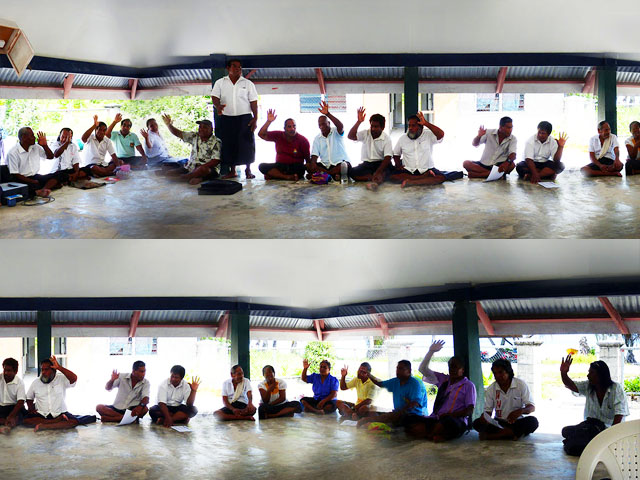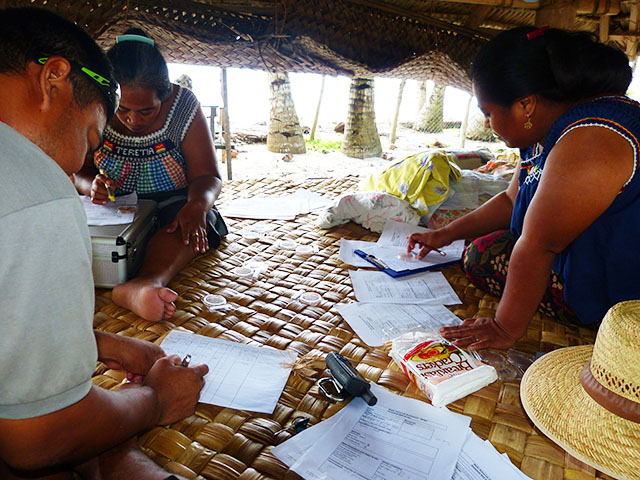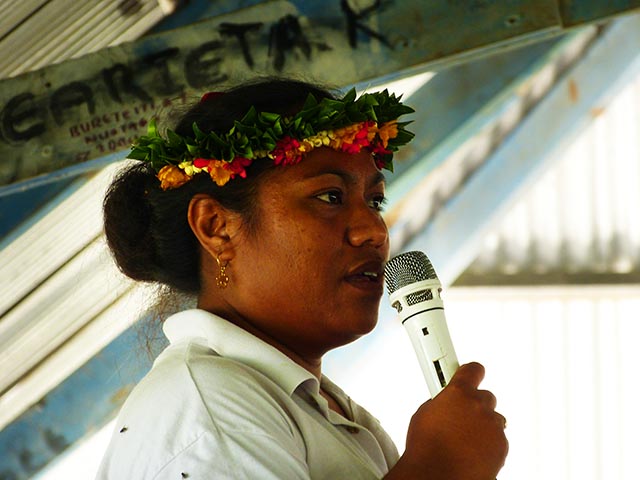
Climate Change Resilience
The Government of Kiribati 'Whole-of-Island' team has returned to Abaiang for the launch of the core elements of the Abaiang Island Council Strategic Action Plan – its vision, mission, objectives and priority actions – and to undertake agricultural, education, fisheries, meteorological and water sector related activities and training on the atoll. The team includes representatives from the Ministry of Education; Ministry of Environment, Lands and Agricultural Development; Ministry of Public Works and Utilities; and Meteorological Service.
The project is being supported by the Secretariat of the Pacific Community (SPC), German Agency for International Cooperation (GIZ) and the Secretariat of the Pacific Regional Environment Programme (SPREP) through generous support from United States Agency for International Development (USAID), the German Ministry for Economic Cooperation and Development (BMZ), European Union (EU) and Australian Aid.
Abaiang lies one degree north of the Equator and is the outer island located the closest to the capital of Tarawa. Over 5,000 people live there, the fourth largest population of any atoll in the nation. The unique culture of Kiribati is evident on Abaiang. Limited external influences have meant that the traditional way of life is in many ways largely intact.
The people of Abaiang face many challenges in daily life. Human habitation on the atoll is only possible due to the presence of an underground freshwater lens. But this water supply is easily contaminated and rapidly becomes too salty for consumption during periods of drought. The soils are amongst the poorest in the world, making agriculture difficult. The lagoon, reefs and ocean waters hold a very wide range of fish and invertebrate species, which are relied upon as the main source of protein in the local diet. However, the pressure on fisheries is ever increasing, no community-based fisheries management practices currently exist and recent surveys have found that these resources are being depleted at an unsustainable rate.
In addressing these issues, the key local authority is the Abaiang Island Council. On 20 May 2014 the council voted unanimously to endorse the core elements of the Abaiang Island Strategic Development Plan 2014–2017.

The plan has the following mission:
Working hand in hand with the communities, central government and partners will result in and improve the Council's efforts to bring prosperity and security to its people through sustainable economic, social and environmental development. This will focus on education, health, economic development, conservation and management of the environment and natural resources, application of organic principles, protection of women, children and people living with disabilities, preservation of culture and other key priorities in the face of climate change.
This development plan also prioritises actions to be undertaken by the 12 projects that have come together under the 'Whole-of-Island' approach in Abaiang. It is a full-fletched development plan that includes an overview of Abaiang with facts and figures and the results of a previously undertaken integrated vulnerability assessment. Over the past week, implementation activities have been taking places in many villages across the atoll.

The Water Engineering Unit from the Ministry of Public Works and Utilities, with support from SPREP and USAID, has been testing well water and selecting specific sites where improved 'Tamana' pumps can be installed. These easily maintained, hand powered pumps greatly reduce bacterial contamination of household water supplies.
'Most of the wells are open and that leaves them vulnerable to overflowing or exposure to dirt and other contaminants that can easily go into the groundwater. So we've visited the six villages that are selected under this project and we've basically selected all the ones that are going to have hand pumps and we've tested them for bacteria and salinity as well,' says Reenate Willie, who is the USAID-SPREP National Project Coordinator based at the Ministry of Public Works.
'After the pumps are installed, the wells can be covered and the water will be kept safe from contamination,' she adds.
Over 60 teachers on Abaiang have also received training on a new picture-based education resource called Learning About Climate Change the Pacific Way. The resource, which includes a teachers' guide and a visual flipchart, is tailored for use in five Pacific Island countries. Kiribati is the first country in which it is being used. The full resource will be launched on 5 June 2014 in Suva, Fiji and has been made possible with generous support from Australia, Germany and the United States of America.

Kiribati Teachers College lecturers and Curriculum Development Resource Centre officers have been facilitating the weeklong training workshops with support from the SPC/GIZ Coping with Climate Change in the Pacific Island Region (CCCPIR) programme, implemented on behalf of the German Government.
'The resource consists of 16 detailed pictures based in the Pacific showing weather, climate, causes and consequences of climate change and details about adaptation measures both currently in place and ones that could be taken,' says SPC/GIZ CCCPIR Education Consultant Carol Young. She adds, 'Although the resource is tailored for year seven and eight students, the teachers are finding that it can be used in all levels and all curriculum areas.'
With guidance from the Kiribati Meteorological Services, basic weather stations have also been installed at three secondary schools on Abaiang, so that students can measure and interpret variables like rainfall, wind and temperature.
The agricultural component of the 'whole-of-island' approach addresses food security on the atoll through the promotion of agro-forestry practices, breeding of improved livestock and the establishment of village nurseries.
The Ministry of Environment, Lands and Agricultural Development's Principal Agriculture Officer, Tokintekai Bakineti says that the Abaiang Island Council has selected three villages for implementation.
'What we've done is we've put members of our team in the villages and that's the main idea: to try and get them involved in the things we're doing for them. Our visit is not very important. How they respond to the issues they've realised is what's important. We're here to help them out and facilitate things for them,' says Bakineti .
A media team from SPC's Communications and Public Relations Unit has also joined the team to document the implementation of the whole-of-island approach on Abaiang.
The whole-of-island approach is being supported through SPC, SPREP, GIZ, Coastal Community Action Program (C-CAP), Pacific Organic and Ethical Trade Community (POETCom), United Nations Development Program (UNDP) and University of the South Pacific (USP) programmes being undertaken on Abaiang. This approach is made possible by generous support from USAID, BMZ, the EU and Australian Aid.
For more information please contact,
Carlo Iacovino, SPREP Climate Change Communications Officer, carloi@sprep.org
Vuki Buadromo, SPC Project Manager, Enhanced Climate Change Resilience of Food Production Systems (USAID Project), vukib@spc.int
Hanna Sabass, SPC/GIZ Climate Change and Education Adviser, Hanna.Sabass@giz.de
Previously released:Friday, 30 May, Secretariat of the Pacific Community (SPC), Suva, Fiji
The project is being supported by the Secretariat of the Pacific Community (SPC), German Agency for International Cooperation (GIZ) and the Secretariat of the Pacific Regional Environment Programme (SPREP) through generous support from United States Agency for International Development (USAID), the German Ministry for Economic Cooperation and Development (BMZ), European Union (EU) and Australian Aid.
Abaiang lies one degree north of the Equator and is the outer island located the closest to the capital of Tarawa. Over 5,000 people live there, the fourth largest population of any atoll in the nation. The unique culture of Kiribati is evident on Abaiang. Limited external influences have meant that the traditional way of life is in many ways largely intact.
The people of Abaiang face many challenges in daily life. Human habitation on the atoll is only possible due to the presence of an underground freshwater lens. But this water supply is easily contaminated and rapidly becomes too salty for consumption during periods of drought. The soils are amongst the poorest in the world, making agriculture difficult. The lagoon, reefs and ocean waters hold a very wide range of fish and invertebrate species, which are relied upon as the main source of protein in the local diet. However, the pressure on fisheries is ever increasing, no community-based fisheries management practices currently exist and recent surveys have found that these resources are being depleted at an unsustainable rate.
In addressing these issues, the key local authority is the Abaiang Island Council. On 20 May 2014 the council voted unanimously to endorse the core elements of the Abaiang Island Strategic Development Plan 2014–2017.

The Abaiang Island Council votes. Photo: C.Iacovino/SPREP.
The plan has the following mission:
Working hand in hand with the communities, central government and partners will result in and improve the Council's efforts to bring prosperity and security to its people through sustainable economic, social and environmental development. This will focus on education, health, economic development, conservation and management of the environment and natural resources, application of organic principles, protection of women, children and people living with disabilities, preservation of culture and other key priorities in the face of climate change.
This development plan also prioritises actions to be undertaken by the 12 projects that have come together under the 'Whole-of-Island' approach in Abaiang. It is a full-fletched development plan that includes an overview of Abaiang with facts and figures and the results of a previously undertaken integrated vulnerability assessment. Over the past week, implementation activities have been taking places in many villages across the atoll.

The project team record results from the testing of water samples. Photo: C.Iacovino/SPREP.
The Water Engineering Unit from the Ministry of Public Works and Utilities, with support from SPREP and USAID, has been testing well water and selecting specific sites where improved 'Tamana' pumps can be installed. These easily maintained, hand powered pumps greatly reduce bacterial contamination of household water supplies.
'Most of the wells are open and that leaves them vulnerable to overflowing or exposure to dirt and other contaminants that can easily go into the groundwater. So we've visited the six villages that are selected under this project and we've basically selected all the ones that are going to have hand pumps and we've tested them for bacteria and salinity as well,' says Reenate Willie, who is the USAID-SPREP National Project Coordinator based at the Ministry of Public Works.
'After the pumps are installed, the wells can be covered and the water will be kept safe from contamination,' she adds.
Over 60 teachers on Abaiang have also received training on a new picture-based education resource called Learning About Climate Change the Pacific Way. The resource, which includes a teachers' guide and a visual flipchart, is tailored for use in five Pacific Island countries. Kiribati is the first country in which it is being used. The full resource will be launched on 5 June 2014 in Suva, Fiji and has been made possible with generous support from Australia, Germany and the United States of America.

Reenate Willie, the SPREP/USAID National Project Coordinator. Photo: C.Iacovino/SPREP.
Kiribati Teachers College lecturers and Curriculum Development Resource Centre officers have been facilitating the weeklong training workshops with support from the SPC/GIZ Coping with Climate Change in the Pacific Island Region (CCCPIR) programme, implemented on behalf of the German Government.
'The resource consists of 16 detailed pictures based in the Pacific showing weather, climate, causes and consequences of climate change and details about adaptation measures both currently in place and ones that could be taken,' says SPC/GIZ CCCPIR Education Consultant Carol Young. She adds, 'Although the resource is tailored for year seven and eight students, the teachers are finding that it can be used in all levels and all curriculum areas.'
With guidance from the Kiribati Meteorological Services, basic weather stations have also been installed at three secondary schools on Abaiang, so that students can measure and interpret variables like rainfall, wind and temperature.
The agricultural component of the 'whole-of-island' approach addresses food security on the atoll through the promotion of agro-forestry practices, breeding of improved livestock and the establishment of village nurseries.
The Ministry of Environment, Lands and Agricultural Development's Principal Agriculture Officer, Tokintekai Bakineti says that the Abaiang Island Council has selected three villages for implementation.
'What we've done is we've put members of our team in the villages and that's the main idea: to try and get them involved in the things we're doing for them. Our visit is not very important. How they respond to the issues they've realised is what's important. We're here to help them out and facilitate things for them,' says Bakineti .
A media team from SPC's Communications and Public Relations Unit has also joined the team to document the implementation of the whole-of-island approach on Abaiang.
The whole-of-island approach is being supported through SPC, SPREP, GIZ, Coastal Community Action Program (C-CAP), Pacific Organic and Ethical Trade Community (POETCom), United Nations Development Program (UNDP) and University of the South Pacific (USP) programmes being undertaken on Abaiang. This approach is made possible by generous support from USAID, BMZ, the EU and Australian Aid.
For more information please contact,
Carlo Iacovino, SPREP Climate Change Communications Officer, carloi@sprep.org
Vuki Buadromo, SPC Project Manager, Enhanced Climate Change Resilience of Food Production Systems (USAID Project), vukib@spc.int
Hanna Sabass, SPC/GIZ Climate Change and Education Adviser, Hanna.Sabass@giz.de
Previously released:Friday, 30 May, Secretariat of the Pacific Community (SPC), Suva, Fiji